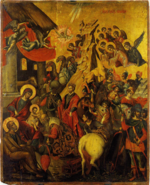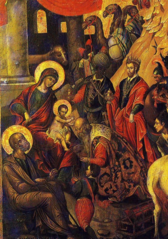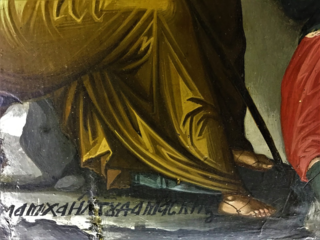
The Adoration of the Magi or Adoration of the Kings or Visitation of the Wise Men is the name traditionally given to the subject in the Nativity of Jesus in art in which the three Magi, represented as kings, especially in the West, having found Jesus by following a star, lay before him gifts of gold, frankincense, and myrrh, and worship him. It is related in the Bible by Matthew 2:11: "On entering the house, they saw the child with Mary his mother; and they knelt down and paid him homage. Then, opening their treasure chests, they offered him gifts of gold, frankincense, and myrrh. And having been warned in a dream not to return to Herod, they left for their own country by another path".

Dormition of the Virgin is a tempera painting on panel executed by El Greco near the end of his Cretan period, probably before 1567. El Greco's signature on the base of the central candelabrum was discovered in 1983. The discovery of the Dormition led to the attribution of three other signed works of "Doménicos" to El Greco and then to the acceptance as authentic of more works, signed or not.
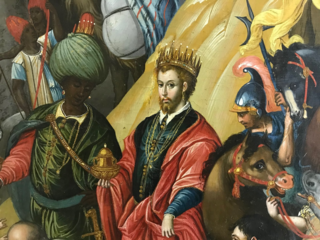
Michael Damaskenos or Michail Damaskenos was a leading post-Byzantine Cretan painter. He is a major representative of the Cretan School of painting that flourished in the 16th and 17th centuries. Painters Georgios Klontzas and Damaskenos were major contributors to the Cretan School during the same period. Damaskinos traveled all over the Venetian Empire painting. He remained loyal to his Greek roots stylistically but incorporated some Italian elements in his work. He was strongly influenced by the Venetian school. He painted parts of the Cathedral of San Giorgio dei Greci. Damaskenos has 100 known works. He influenced the works of Theodore Poulakis.

The Nativity of Jesus has been a major subject of Christian art since the 4th century.

Theodore Poulakis was a Greek Renaissance painter and teacher. He is considered the father of the Heptanese School and one of the most prolific painters of Venetian Crete. Poulakis was a member of the Cretan School, his contemporary was Emmanuel Tzanes. Emmanuel Tzanes and Poulakis were active painters of the Cretan School until Candia, went to war with the Ottomans around 1649. Candia finally fell after twenty years of siege in 1669. Poulakis settled on the island of Corfu. Stephanos Tzangarolas was another famous painter in Corfu around the same period. Poulakis's works are likened to Andreas Pavias and Georgios Klontzas. Poulakis works exhibit qualities of the Venetian school. Over 130 of his paintings have survived and can be found all over the world.

Christ Bearing the Cross is a painting in tempera attributed to the Greek painter Nikolaos Tzafouris. Tzafouris is considered one of the founding members of the Cretan School along with Andreas Ritzos, Andreas Pavias, and Angelos Akotantos. He was influenced by Angelos Akotantos. According to the Institute of Neohellenic Research, thirteen paintings are attributed to Tzafouris. Active between 1480 and 1501, Tzafouris had a workshop in Heraklion, where he painted religious themes for local churches. His most notable works are the Madre della Consolazione and Christ Bearing the Cross.

Georgios Kastrofylakas (Greek: Γεώργιος Καστροφύλακας, 1699/1705 – 1760/1770), also known as Georgios Kastrofylax or (Zorzis). He is one of the few Greek painters that remained in Crete. Others included Ioannis Kornaros. Kornaros was his student. Kastrofylakas followed the lines of the Cretan School. His work was influenced by legendary artists such as Georgios Klontzas, Michael Damaskinos and Angelos. Historians argue Kastrofylakas had many students due to the resemblance of his work. He belongs to the Neo-Hellenikos Diafotismos in painting and the Greek Rococo period. He influenced countless Greek iconographers. Thirty-six paintings are attributed to Kastrofylakas. The artist added more realism to his paintings. Most of his artwork is in Heraklion, Crete. His most notable work is the Adoration of the Magi.

The Last Supper is a tempera painting by Greek painter Michael Damaskinos. He painted in Heraklion, Sicily, Venice, and other parts of Italy. His painting of the Last Supper is considered the Greek Last Supper and is comparative to Leonardo da Vinci's masterpiece painted one hundred years prior. The two painters employed different painting styles but the subjects pose similarities. Damaskinos's painting features a feminine figure similar to that of Leonardo da Vinci's The Last Supper. The Damaskinos Last Supper is now in the Monastery of Agia Aikaterini in Heraklion, Crete. It is part of the collection of Saint Catherine's Monastery near Mount Sinai, Egypt.

Wedding at Cana also known as Wedding Feast at Cana and Le Nozze di Cana is an oil painting by Michael Damaskinos. He was active during the second half of the 16th century in Heraklion, Sicily, Venice, and different parts of Italy. Over 100 works are attributed to the artist. Most of his work resembled the Greek mannerisms prevalent at the time also known as maniera greca. He was clearly influenced by Venetian painting. His version of the Wedding at Cana was a copy of Tintoretto's massive painting of the Wedding Feast at Cana. The monumental canvas was 4.4 m x 5.9 m or 14.4 ft x 19.3 ft. The painting was originally in the dining hall (refectory) of the convent of the Crociferi in Venice. Refectories typically featured large paintings of biblical banquet scenes. The monks preferred biblical banquet scenes because they desired the impression of dining with Christ. Damaskinos probably saw the painting at the convent or a copy of the masterpiece in Venice. The Damaskinos version is much smaller than the original. The painting is very important because it is one of the few instances where Damaskinos broke from the traditional maniera greca prevalent in most of his works. In this instance, he strictly followed the lines of Venetian painting exhibiting his superior craftsmanship as a painter capable of changing his style. El Greco was another painter who also painted in both styles. The Damaskinos version is currently at the Museo Correr in Venice, Italy.

The Stoning of Saint Stephen is an egg tempera and gold leaf painting created by Greek master Michael Damaskinos. He was a member of the Cretan school. He integrated Venetian painting with the Greek mannerisms prevalent at the time. Damaskinos was active in Heraklion, Sicily, Venice, and other parts of Italy. The Stoning of Stephen has been depicted by countless Greek and Italian painters. Saint Stephen was a protomartyr. He was the first martyr of Christianity. He was stoned to death for following the new faith. The painting is a depiction of that event.
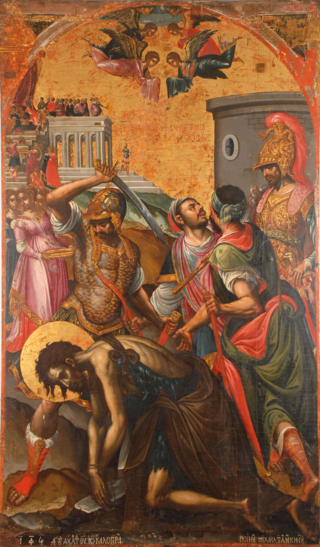
The Beheading of John the Baptist was a painting made of egg tempera and gold leaf. It was similar in length to Damaschino's Stoning of Stephen. Michele Damaschino was a famous member of the Cretan school of painting. His contemporaries were El Greco and Georgios Klontzas. Damaschino was from Crete, he spent a large amount of time in Venice. While in Venice, and other parts of Italy, he adopted Italian mannerisms which he applied to his painting technique. The Beheading of John the Baptist was a popular theme among Greek and Italian painters.

The Last Judgement Triptych is a triptych by Georgios Klontzas. Klontzas was a Greek painter and prominent member of the Cretan School. He is likened to El Greco and Michael Damaskinos. His artistic period was between 1550 and 1608. He had a workshop in Heraklion, Crete. He created many forms of art such as triptychs, portable icons or paintings, and manuscripts. Klontzas created several versions of the Last Judgment or Second Coming. His The Last Judgment also features the same theme but is a painting, not a triptych. Klontzas also created other triptychs.

The Virgin of the Burning Bush was a painting made of egg tempera and gold leaf on a wood panel. The portable icon was signed by Greek painter Michael Damaskinos. Damaskinos has over 100 known works. He was a distinguished member of the Cretan school of painting. He was from Crete. His contemporaries included Georgios Klontzas and El Greco. Damaskinos spent over twenty years traveling all over Italy. He spent a significant time in Venice. He adopted Italian artistic mannerisms which he applied to his paintings.

Madonna of Constantinople is a tempera painting created by Greek painter Angelos Pitzamanos. Angelo was from the island of Crete. He was active from 1482 to 1535. His teacher was famous painter Andreas Pavias. Angelo finished commissions with his brother Donatus Pitzamanos. Eleven remaining works are attributed to Angelo. He signed most of his works in Latin, his signature poem was Angelus Bizamanus the Greek painter from Crete.

The Virgin and Child on Bronze is an egg tempera painting by Greek painter Elias Moskos. Moskos was originally from Crete. The painter migrated to Zakinthos. Two other painters with the name Moskos were active during his lifetime. They were Ioannis Moskos and Leos Moskos. All three painters were affiliated with Venice. Fifty-two of Elias's paintings survived. It is difficult to characterize the work of some painters belonging to the late Cretan School. Some artists also belong to the Heptanese School. The technical migration from the maniera Greca of Cretan-Venetian painting to the more refined Ionian-Venetian style is visible in the works of Elias Moskos and Theodoros Poulakis. His painting of the Virgin and Child drastically migrates from the traditional mannerism prevalent in Cretan painting. The painting clearly belongs to the Heptanese School. His painting of the Virgin and Child is at the Benaki Museum in Athens Greece.

The Virgin Glykofilousa with the Akathist Hymn is a tempera painting created by Greek painter Stephano Tzangarola. The work is a symbol of the craftsmanship of the Heptanese school and the evolution of Greek painting from the Byzantine style to the Cretan Renaissance style. Tzangarola was originally from Crete and migrated to Corfu. The Ionian Islands became the artistic center of the Greek world. He was active from 1675 to 1710 during the Greek Baroque period and Rococo. Twenty-two of his works survived. His student was famous Greek painter and Archpriest Andreas Karantinos.
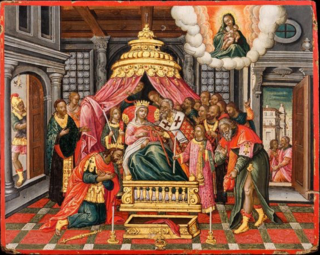
The Miracle of the Holy Belt was completed by Theodore Poulakis. He was a Greek painter originally from the village of Chania, Crete. He was associated with the Cretan School. He eventually migrated to the Ionian Islands. He was a member of the Heptanese School. He settled on the island of Corfu. He was a famous teacher. He signed a six-year contract to teach painting to Marinos Damistras son Tzorzi. The contract stipulated that his student had to follow him to Venice. Poulakis frequently traveled all over the Venetian Empire. During one period of his life, he stayed in Venice for over 13 years. He was very active within the painting community. He was also involved with the prestigious quarantia council. One hundred thirty of his work survived. The Girdle of Thomas also referred to as the miracle of the holy belt is a sacred relic located at Prato Cathedral in Tuscany, Italy.

The Nativity is an egg tempera painting by Victor. Victor is sometimes referred to as Victor of Crete. Victor was active from 1645 to 1696. He traveled all over the Venetian empire. He settled in Zakinthos. Some of his important works can be found in the church San Giorgio dei Greci in Venice. He is a very important Greek painter because of his existing catalog. His works of art exceed ninety-five paintings. One of his notable works was his version of Christ the Vine.

Transfiguration and Monastic Scenes is a multi-themed tempera painting created by Greek painter Georgios Klontzas. Klontzas was a Cretan Renaissance painter. The artist was hired to assess work completed by El Greco. Klontzas was from a wealthy family and owned a successful workshop in the center of Crete. His existing catalog consists of Fifty-four works. He completed incredible triptychs and manuscripts. Klontzas and Micheal Damaskinos are two of the most prominent Greek painters of the 16th century due to the size of their catalogs and the popularity of their works excluding El Greco.

Madonna del Rosario was a painting made of egg tempera on a wood panel nearly 11 feet in height. The work of art was signed by Greek painter Michael Damaskinos and the painter's existing catalog features over 100 known works. Damaskinos was from the island of Crete and he was a prominent member of the Cretan school of painting. His contemporaries were Georgios Klontzas and El Greco. Damaskinos was known for integrating the Venetian style of painting with the maniera greca creating his own unique style. The Madonna del Rosario follows the Venetian style. The painter frequently traveled from Crete to Venice but also spent time painting in Sicily and Conversano from 1569 to 1575. He was familiar with the works of Mannerist Parmigianino and other Italian painters because he purchased a collection of drawings from his friend Italian sculptor Alessandro Vittoria. Damaskinos was influenced by the works of Venetian masters Palma Giovane, Paolo Veronese, Tintoretto and Titian.

